TESTING THE XJR5
The Jaguar Marque magazine published in Fall 1982 included an article written by Editor, Harvey Turner on ‘TESTING THE XJR5’.
They were hot, sweaty and tired but the tension of designer, drivers and crew of the new Jaguar XJR5 prototype was almost palable as the car was offloaded from the big transporter into the blazing Georgia sun.
They were about to unleash the new Group 44 entry on a big league road racing circuit for the first time to “see what she would do.” Months of painstaking work and a fair number of dollars had gone into the construction of what must be the fastest Jaguar ever. Being the sole current bearer of Jaguar’s racing colors in one of the top racing classes in the world, when considered against the backdrop of Jaguar’s long winning tradition, must surely carry with it a certain amount of pressure.
Preliminary shake-down runs had been conducted at Summit Point, W. Va., but this session at Road Atlanta was to be the first serious test for the car. We had managed to wheedle an invitation to watch and record something of our impressions of the car and its progress to date.
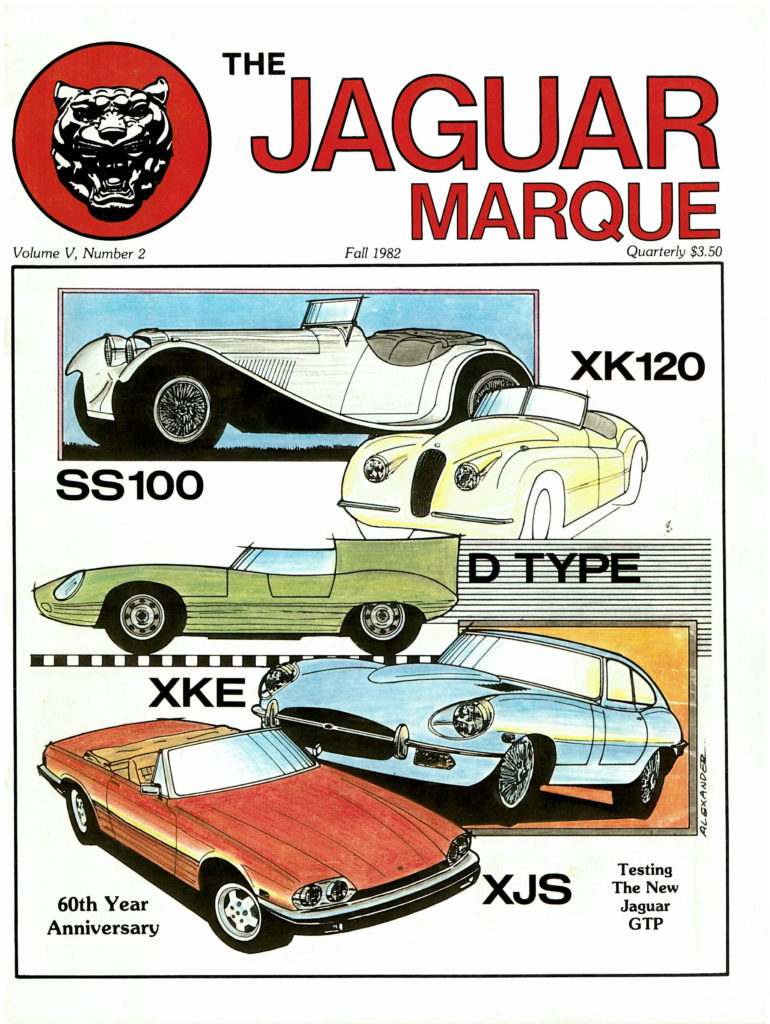
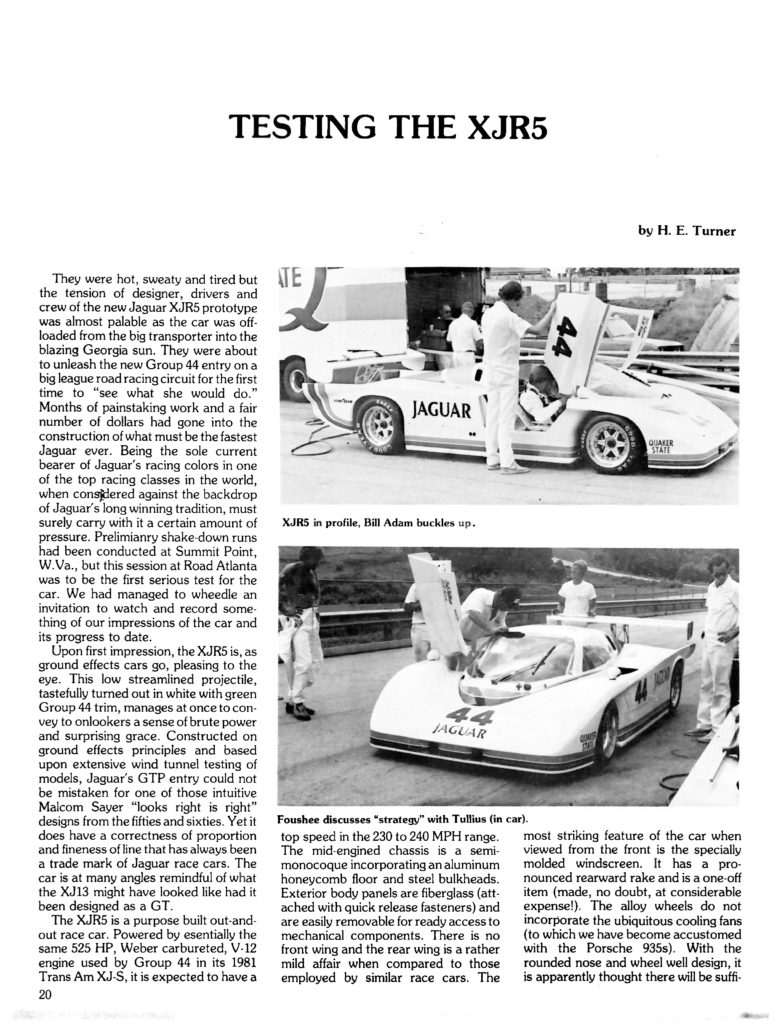
Upon first impression, the XJR5 is, as ground effects cars go, pleasing to the eye. This low streamlined projectile, tastefully turned out in white with green Group 44 trim, manages at once to convey to onlookers a sense of brute power and surprising grace. Constructed on ground effects principles and based upon extensive wind tunnel testing of models, Jaguar’s GTP entry could not be mistaken for one of those intuitive Malcom Sayer “looks right is right” designs from the fifties and sixties. Yet it does have a correctness of proportion and fineness of line that has always been a trade mark of Jaguar race cars. The car is at many angles remindful of what the XJ13 might have looked like had it been designed as a GT.
The XJR5 is a purpose built out-and-out race car. Powered by essentially the same 525 HP, Weber carbureted, V-12 engine used by Group 44 in its 1981 Trans Am XJ-S, it is expected to have a top speed in the 230 to 240 MPH range. The mid-engined chassis is a semi-monocoque incorporating an aluminum honeycomb floor and steel bulkheads.
Exterior body panels are fiberglass (attached with quick release fasteners) and are easily removable for ready access to mechanical components. There is no front wing and the rear wing is a rather mild affair when compared to those employed by similar race cars. The most striking feature of the car when viewed from the front is the specially molded windscreen. It has a pronounced rearward rake and is a one-off item (made, no doubt, at considerable expense!).
The alloy wheels do not incorporate the ubiquitous cooling fans (to which we have become accustomed with the Porsche 935s). With the rounded nose and wheel well design, it is apparently thought there will be sufficient extraction of hot air (generated by heavy braking) by reason of the air flow along the sides of the body. The car is a cornucopia of the latest in high-tech racing components, from the vented rotor, four piston Lockheed disc brakes and built-in air jacks to the state of the art electronics and instrumentation. Fit and finish throughout are quite high and, as with all Group 44 efforts, the overall effect is professional. The XJR5 is definitely not your average home-built club racing special and it is as different from a production based race car as it can be.
After unloading, the car is given a thorough going over (checking brakes, suspension, engine and tires) and then major domo Tullius, chief designer Dykstra and Group 44 crew chief Foushee hover over their creation, as the crew fired the V-12 and began warming it up for its first run. If looks and sound alone will produce a winner, the XJR5 has nothing to fear. The V-12, breathing through six twin-choke downdraft Webers and shortened (resulting from mid-engine location) tuned headers, sounds as ferocious as any Ferrari ever did. The roar of the engine reverberated through the hills and trees of the deserted circuit.
The drivers are Bob Tullius and Bill Adam. Tullius is a veteran with winning ways. This will be his seventh year piloting Jaguar race cars; his first was 1974. In 1975, Tullius took a Jaguar V-12 E-Type to the B-Production SCCA National Championship. In 1976, he campaigned Group 44’s first XJ-S in both Trans-AM and SCCA Production races missing a repeat SCCA Championship at Road Atlanta due to a minor engine fire at turn seven. In 1977 and ’78, he switched full-time to the Trans-Am circuit, winning the Category 1 Driver’s Championship both years and the Manufacturer’s Title for Jaguar in ’78. In 1981, he won more Trans-Am races than any other driver but narrowly missed the title on points.
The other driver, Canadian Bill Adam, is the younger of the pair. He joined the Group 44 team in 1980 and co-drove a Triumph TR8 with Tullius in IMSA events. He has also raced the XJ-S, most recently co-driving with Tullius in the 1982 Daytona 24.hour.
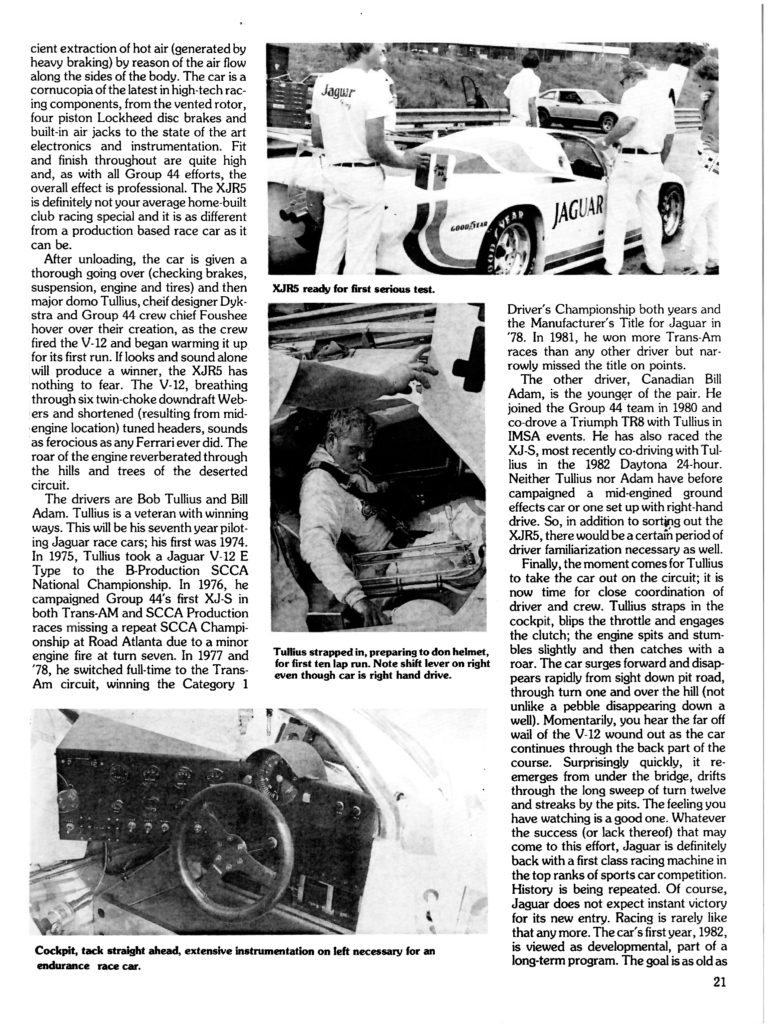
Neither Tullius nor Adam have before campaigned a mid-engined ground effects car or one set up with right-hand drive.
So, in addition to sorting out the XJR5, there would be a certain period of driver familiarization necessary as well. Finally, the moment comes for Tullius to take the car out on the circuit; it is now time for close coordination of driver and crew. Tullius straps in the cockpit, blips the throttle and engages the clutch; the engine spits and stumbles slightly and then catches with a roar. The car surges forward and disappears rapidly from sight down pit road, through turn one and over the hill (not unlike a pebble disappearing down a well). Momentarily, you hear the far off wail of the V-12 wound out as the car continues through the back part of the course. Surprisingly quickly, it re-emerges from under the bridge, drifts through the long sweep of turn twelve and streaks by the pits. The feeling you have watching is a good one. Whatever the success (or lack thereof) that may come to this effort, Jaguar is definitely back with a first class racing machine in the top ranks of sports car competition. History is being repeated. Of course, Jaguar does not expect instant victory for its new entry. Racing is rarely like that anymore.
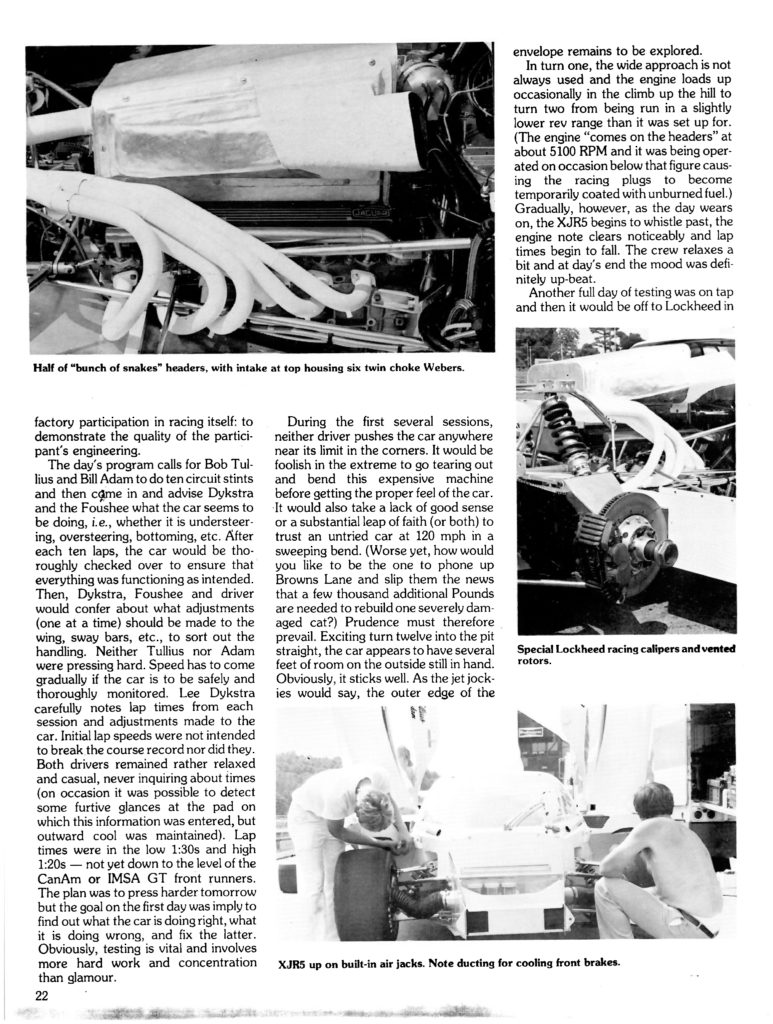
The car’s first year, 1982, is viewed as developmental, part of a long-term program. The goal is as old as factory participation in racing itself: to demonstrate the quality of the participant’s engineering.
The day’s program calls for Bob Tullius and Bill Adam to do ten circuit stints and then come in and advise Dykstra and the Foushee what the car seems to be doing, i.e., whether it is understeering, oversteering, bottoming, etc. After each ten laps, the car would be thoroughly checked over to ensure that everything was functioning as intended. Then, Dykstra, Foushee and driver would confer about what adjustments (one at a time) should be made to the wing, sway bars, etc., to sort out the handling. Neither Tullius nor Adam were pressing hard. Speed has to come gradually if the car is to be safely and thoroughly monitored. Lee Dykstra carefully notes lap times from each session and adjustments made to the car. Initial lap speeds were not intended to break the course record nor did they.
Both drivers remained rather relaxed and casual, never inquiring about times (on occasion it was possible to detect some furtive glances at the pad on which this information was entered, but outward cool was maintained). Lap times were in the low 1:30s and high 1:20s – not yet down to the level of the CanAm or IMSA GT front runners. The plan was to press harder tomorrow but the goal on the first day was imply to find out what the car is doing right, what it is doing wrong, and fix the latter. Obviously, testing is vital and involves more hard work and concentration than glamour.
During the first several sessions, neither driver pushes the car anywhere near its limit in the corners. It would be foolish in the extreme to go tearing out and bend this expensive machine before getting the proper feel of the car.
It would also take a lack of good sense or a substantial leap of faith (or both) to trust an untried car at 120 mph in a sweeping bend. (Worse yet, how would you like to be the one to phone up Browns Lane and slip them the news that a few thousand additional Pounds are needed to rebuild one severely damaged cat?) Prudence must therefore prevail. Exciting turn twelve into the pit straight, the car appears to have several feet of room on the outside still in hand. Obviously, it sticks well. As the jet jockies would say, the outer edge of the envelope remains to be explored.
In turn one, the wide approach is not always used and the engine loads up occasionally in the climb up the hill to turn two from being run in a slightly lower rev range than it was set up for. (The engine “comes on the headers” at about 5100 RPM and it was being operated on occasion below that figure causing the racing plugs to become temporarily coated with unburned fuel.) Gradually, however, as the day wears on, the XJR5 begins to whistle past, the engine note clears noticeably and lap times begin to fall. The crew relaxes a bit and at day’s end the mood was definitely up-beat.
Another full day of testing was on tap and then it would be off to Lockheed in Marietta for wind tunnel testing of the real thing. John Steen who observed this phase, tells us all went well insofar as a layman could tell, the XJR5 passing all tests so far. Dykstra and Tullius are not interested, of course, in broadcasting to the world all their secrets and so are a bit taciturn on performance times and numbers. And so it should be.
During intervals between testing, there was some entertaining banter among bystanders, drivers and crew. Tullius indicated some of the fervor of his troops when he observed that a crew member’s wife was expecting and the date of expected birth was approximately the date of the XJR5’s first race. When asked whether he would attend the race, the crew member said, “If I don’t attend, you’ll know I’m dead and buried.” Tullius also related that after construction of the car was finished, the eagerness of the Group 44 crew was strained by the wait until the testing date at Road Atlanta and Lockheed’s wind tunnel.
One of the freer spirits suggested that they take it out on route 50 in Virginia for a spin. His somewhat tongue-in-cheek solution if the local constabulary was encountered was to simply outrun them. After being informed that the cops would just be waiting at the Group 44 shops, he had a ready answer. “We could simply change the number of the car in advance so no one would know who it is.” As W. C. Fields would say, “ Ah yes. . .”
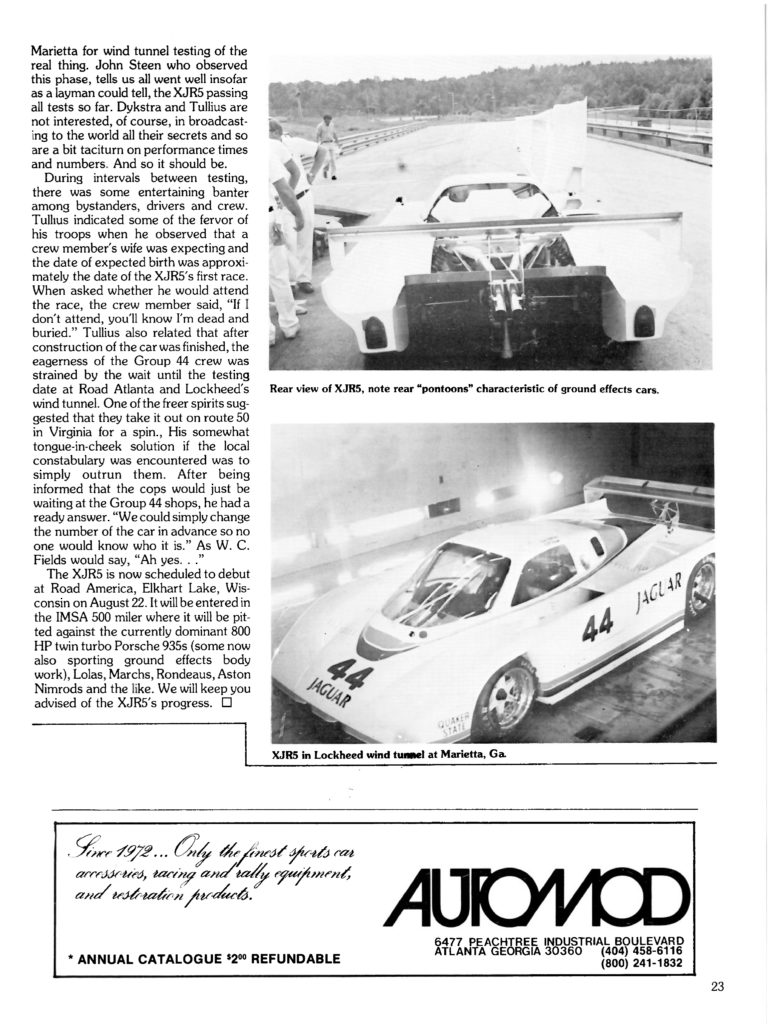
The XJR5 is now scheduled to debut at Road America, Elkhart Lake, Wisconsin on August 22. It will be entered in the IMSA 500 miler where it will be pitted against the currently dominant 800 HP twin turbo Porsche 935s (some now also sporting ground effects bodywork), Lolas, Marchs, Rondeaus, Aston Nimrods and the like. We will keep you advised of the XJR5’s progress.